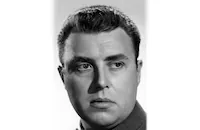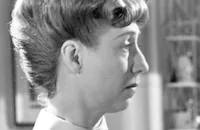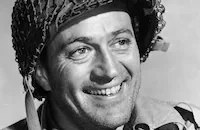The Gangster

Brief Synopsis
Cast & Crew
Gordon Wiles
Barry Sullivan
Belita
Joan Lorring
Akim Tamiroff
Henry Morgan
Film Details
Technical Specs

Synopsis
On Neptune Beach in New York City, racketeer Shubunka owns a soda fountain shop, which is run by Nick Jammey. Racketeer Cornell and his gang plan to take over all of Shubunka's rackets and force Jammey to meet with them. Although Shubunka's girl friend, Nancy Starr, a show girl, is genuinely in love with him, Shubunka's paranoia about Cornell causes him to fly into a rage against her. Meanwhile, weak-minded accountant Frank Karty, a regular at the soda shop who compulsively bets on horses, begs Shubunka to lend him some money or let him in on one of his rackets, but Shubunka refuses to help him. Dorothy, the soda shop cashier, quits in disgust at Shubunka's lack of conscience, and he tries to give her $200 as a going away present after refusing Karty the money. Karty's wife later comes into the shop to warn Karty that her brothers are after him for stealing $1,300 from their mechanics garage. Cornell forces Jammey to a lunch meeting in which he orders him to hand over a list of the locations of Shubunka's rackets. Jammey refuses out of loyalty to Shubunka. When Nancy suggests to Shubunka they enjoy a secluded picnic on the beach, and Cornell's men beat him up there, he accuses her of setting him up. One by one Shubunka's connections begin to turn on him. Fearing for his life, Shubunka makes plans to skip town with Nancy, but when she offers to pawn all the expensive gifts he has given her, he becomes determined to fight Cornell by hiring new men to run his rackets. Meanwhile, Karty's wife, who hasn't seen Karty in two days, comes looking for him at the soda shop. Despairing, Karty again asks Shubunka for help and is again turned down. Dorothy again upbraids Shubunka for his immoral life, but he becomes that much more determined to fight Cornell. He then discovers that Jammey has turned over the location list to Cornell. When Cornell offers Shubunka a job as a collector, he bitterly turns it down, assuring Jammey that he is still working for him. Cornell warns Shubunka that if he kills Jammey, he will be killed within twenty minutes. Karty is beaten up by his in-laws and promises to return their money, then goes to Jammey, who refuses to steal from Shubunka for him. Karty hits Jammey over the head with a frying pan, and he dies. When Shubunka comes to pick up Nancy, he finds Cornell and his men waiting for him. Shubunka accuses Nancy of setting him up, and she explains that while she loved him in the beginning, his paranoia has now made her hate him. She adds that when Cornell offered her a part on Broadway, she decided to turn Shubunka in. Shubunka later learns that Jammey was murdered, and, terrified that he will be blamed, he seeks refuge in Dorothy's apartment, where she lives with her father. Dorothy tells Shubunka that although Karty has confessed to Jammey's murder, he is really to blame, and that he should be forced to pay for his sins. With nowhere to turn, Shubunka walks into the rainy night, and as he shouts to Cornell that he can "have it all," he is gunned down. Later, Cornell and his gang are apprehended.

Director
Gordon Wiles
Cast

Barry Sullivan
Belita

Joan Lorring

Akim Tamiroff

Henry Morgan

John Ireland

Sheldon Leonard
Fifi D'orsay
Virginia Christine

Elisha Cook Jr.
Theodore Hecht

Leif Erickson

Charles Mcgraw
John Kellogg
Edwin Maxwell
Dewey Robinson

Griff Barnett
Murray Alper

Shelley Winters
Larry Steers
Clancy Cooper

Jeff Corey

Peter Whitney
Bill Kennedy
Mike Conrad
Jack Reynolds
Larry Thompson
Rex Downing
Ruth Allen

Billy Gray

Norma Jean Nilsson
Pat Emery
Lennie Bremen
Alexander Pope
Maxine Semon

Marie Blake
Anita Turner
Phyllis Ayres
Dolores Castle

Sidney Melton
Delese Daudet
Jean Harrison
Tommy Reilly

Don Haggerty
Michael Vallon
Jane Weeks
Parker Gee

Greta Grandstedt
Marguerita Padula
Mike Lally
Sammy Shack
Jean Calhoun
Helen Alexander
Mike Gaddis
Jay Eaton
Zona King
Irene Brooks
Ralph Freeto
Gene Collins
Andy Andrews
Phil Arnold
Crew
Rose Alexander
Nacio Herb Brown
Leon Charles
Gordon Clifford
Daniel Fuchs
Arthur Gardner
Louis Gruenberg
Frank S. Heath
Paul Ivano
Frank King
Frank King
Herman King
Maurice King
Maurice King
Sidney Moore
Norma
William Randall
Roy W. Seawright
F. Paul Sylos
Irvin Talbot
Walter Thompson
Ern Westmore

Videos
Movie Clip



Hosted Intro
Film Details
Technical Specs

Articles
The Gangster (1947) -
Their finest film, Gun Crazy (1950), would come along three years later, but for the moment they concentrated on The Gangster, a raw, bitter portrait of a racketeer (Barry Sullivan) becoming increasingly paranoid and full of self-doubt as he grapples with a rival gangster (Sheldon Leonard), a girlfriend he thinks is two-timing him (Belita), and a gambler who pleads for money (John Ireland).
This film is offbeat, with a psychological focus that some consider pretentious and theatrical, though it's certainly compelling. It's also certainly a film noir, with its seamy portrayal of doomed underworld characters and a fine supporting cast of noir stalwarts including Akim Tamiroff, Henry Morgan, Charles McGraw, and Elisha Cook, Jr. (Keep a lookout for Shelley Winters as a cashier.)
Sullivan and Belita had already co-starred in another film noir, Suspense (1946), and Sullivan himself had appeared in Framed (1947) and would go on to play in many more noirs including Tension (1949), The Unknown Man (1951), and Loophole (1954).
The actress known as Belita (birth name: Maria Belita Jepson-Turner) was a professional ice skater brought to Hollywood to try and replicate the success of another European skater, Sonja Henie. While Belita did make a few ice skating films such as Ice-Capades (1941) and Silver Skates (1943), she wound up perhaps better remembered by movie fans for her acting roles in her low-budget noirs (though in Suspense, she also skates!).
Based on a Daniel Fuchs novel entitled Low Company, The Gangster screenplay was adapted by Fuchs himself -- and, some sources claim, an uncredited Dalton Trumbo. Fuchs was a key player in the history of film noir, writing such notable entries as Hollow Triumph (1948), Criss Cross (1949), and Panic in the Streets (1950). Later he wrote the James Cagney/Doris Day classic Love Me or Leave Me (1955).
Gangster director Gordon Wiles had an unusual back-and-forth career as art director and director. He started as an art director in the early 1930s (winning an Oscar for Transatlantic [1931]), then transitioned to directing in 1935, and moved back into art direction and production design in the early 1940s. He stepped into his director shoes one more time for The Gangster, but only after the film's original director, Edward Blatt, departed over scheduling issues. Wiles died in 1950 at age 46.
By Jeremy Arnold

The Gangster (1947) -
Quotes
I knew everything I did was low and rotten. What did I care what people thought of me. I despised them.- Shubunka
My sins are that I wasn't tough enough. I should have trusted no one; never loved a girl. I should have smashed first. That's the way the world is.- Shubunka
Trivia
Notes
This film's working title was Low Company (The Story of Shubunka). The character "Shubunka" provides a spoken prologue and epilogue. Art director Gordon Wiles made his directorial debut in the film. Hollywood Reporter news items add the following information about the production: In mid-December 1946, Wiles replaced director Edward Blatt, who left the picture because of scheduling conflicts. Leo Carrillo was cast in a role, but did not appear in the completed film. Shortly before principal photography was to begin, actress Belita was suspended from the film after she objected to the fact that Barry Sullivan was to be billed above her. Allied accused Belita of planting publicity stories claiming that the studio was forcing her to wear an indecent costume and had banned her husband, Joel McGinnis, from the set. By early February 1947, however, the dispute was settled and Belita returned to the production. Sullivan was billed above Belita in the final onscreen credits. Allied borrowed photographer Paul Ivano from Universal for the production. Hollywood Reporter news items add Will Orlean and Diane Lee Stewart to the cast, but their appearance in the completed film has not been confirmed.
Although the exact nature of Shubunka's rackets is not revealed in the story, according to memos in the MPAA/PCA Collection at the AMPAS Library, Breen Office representatives got the "unmistakable impression that he is the operator of a chain of brothels." All references to prostitution were omitted from the final film. Although the Breen Office maintained that "Shubunka's" financial support of "Nancy" was an "inescapable inference of an illicit sex affair between the two," the inference remained in the picture. The Breen Office also objected to "Cornell" and his men getting off "scot free," and the ending was changed for the final film. A March 6, 1947 Breen office memo claimed that on a "recent occasion" the King Brothers were heard "making loud, unpleasant boasts that, because they had money, they could push things past the Breen Office and were making it known, either directly or by inference that questionable material could have its way bought through the PCA."
As recorded in a memo on July 23, 1947, the Breen Office tried to persuade the King Brothers to change the film's title, but they refused on the grounds that they had "no [Ingrid] Bergmans or [Clark] Gables" and had to use "rather sensational titles to interest the public in their product." Leif Erickson replaced Hardie Albright in the role of "Beaumont," according to PCA files. In May 1947, Hollywood Reporter announced that the picture was being dubbed into French and Spanish. In February 1954, the film was re-released by Allied Artists with the 1945 Monogram film Dillinger.
















